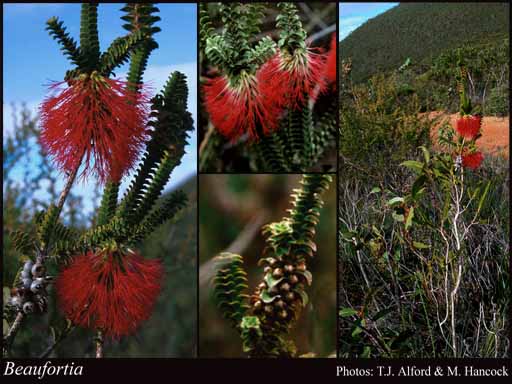- Reference
- W.T.Aiton, Hort.Kew. [W. Aiton] Ed. 2, 4:418 (1812)
- Name Status
- Current







Scientific Description
Common name. Bottlebrushes. Family Myrtaceae.
Habit and leaf form. Shrubs; evergreen; bearing essential oils. Plants with neither basal nor terminal concentrations of leaves; to 0.2–3 m high. Leptocaul. Helophytic, or mesophytic. Leaves minute to small; opposite (usually); decussate; ‘herbaceous’, or leathery; petiolate; gland-dotted; aromatic; simple; epulvinate. Leaf blades dorsiventral, or isobilateral, or centric; entire; flat, or rolled, or solid; linear, or lanceolate, or oblong, or ovate; linear, or ovate, or obovate, or elliptic, or orbicular; pinnately veined, or parallel-veined, or one-veined; cross-venulate, or without cross-venules. Leaves without stipules; without a persistent basal meristem. Stem anatomy. Secondary thickening developing from a conventional cambial ring.
Reproductive type, pollination. Fertile flowers hermaphrodite and functionally male. Unisexual flowers present. Plants andromonoecious (commonly). Entomophilous, or ornithophilous. Pollination mechanism unspecialized.
Inflorescence and flower features. Flowers aggregated in ‘inflorescences’; in spikes, or in heads. Inflorescences simple, or compound. The terminal inflorescence unit cymose. Inflorescences terminal; pseudanthial. Flowers sessile; bracteate (bracts membranous); (bi) bracteolate; small to medium-sized; regular; 5 merous; cyclic. Free hypanthium present (petals ‘inserted on the calyx’); campanulate (or cup-shaped); extending beyond ovary. Hypogynous disk present. Perianth with distinct calyx and corolla; 10; 2 -whorled; isomerous. Calyx present; 5; 1 -whorled; polysepalous, or gamosepalous (depending on interpretation); lobed; imbricate, or valvate; exceeded by the corolla, or more or less equalling the corolla, or exceeding the corolla; regular. Sepals triangular. Calyx lobes triangular. Corolla present; 5; 1 -whorled; polypetalous; imbricate; regular; hairy abaxially (ciliate), or glabrous abaxially; hairy adaxially (ciliate), or glabrous adaxially; white, or yellow, or red, or pink, or purple. Androecial members definite in number, or indefinite in number (usually). Androecium 15–75. Androecial members branched. Androecial sequence determinable, or not determinable. Androecial members maturing centripetally; free of the perianth; all equal, or markedly unequal (when claws or free filaments of unequal length); coherent (bundled into staminal claws); 5 - adelphous. The androecial groups opposite the petals. Stamens 15–75; becoming exserted (exceeding the petals); not didynamous, not tetradynamous; all more or less similar in shape; polystemonous; alternisepalous; all opposite the corolla members; erect in bud, or inflexed in bud. Filaments not geniculate; hairy, or glabrous; filiform. Anthers all alike; basifixed; erect; non-versatile; dehiscing transversely (cells opening at the summit by transverse semi-circular valves or slits, with the lower part of the anther wall folding back and forming a crest which shapes the platform on which the pollen is presented); introrse; bilocular (cells divergent, attached back to back); tetrasporangiate; appendaged, or unappendaged. Fertile gynoecium present, or absent (male flowers). Gynoecium 3 carpelled. The pistil 3 celled. Gynoecium syncarpous; eu-syncarpous; inferior, or partly inferior. Ovary plurilocular; 3 locular. Ovary summit hairy, the hairs not confined to radiating bands. Epigynous disk absent. Gynoecium non-stylate, or stylate. Styles 1; simple; from a depression at the top of the ovary; apical; becoming exserted. Stigmas 1. Placentation axile. Ovulodes present (minute, representing the upper pair of ovules), or absent. Ovules 1(–3) per locule; horizontal (and peltate); non-arillate; anatropous.
Fruit and seed features. Fruit non-fleshy; dehiscent; a capsule (3-valved). Capsules septicidal, or loculicidal, or denticidal, or circumscissile. Fruit 3 seeded. Seeds 1 per locule. Seeds non-endospermic; winged (wing single). Seed wings not encircling body (terminal). Cotyledons 2.
Geography, cytology, number of species. Native of Australia. Endemic to Australia. Australian states and territories: Western Australia. South-West Botanical Province.
Etymology. After Mary, Duchess of Beaufort (1630–1714), who maintained botanical gardens at Badminton and Chelsea and had a large collection of drawings of flowers.
Taxonomic Literature
- Wheeler, Judy; Marchant, Neville; Lewington, Margaret; Graham, Lorraine 2002. Flora of the south west, Bunbury, Augusta, Denmark. Volume 2, dicotyledons. Australian Biological Resources Study.. Canberra..
- Brooks, K. J.; Burbidge, Andrew A.; George, A. S. 1998. Beaufortia aestiva (Myrtaceae) : a new species from the northern kwongan of the South-West Botanical Province, Australia.
- Marchant, N. G.; Wheeler, J. R.; Rye, B. L.; Bennett, E. M.; Lander, N. S.; Macfarlane, T. D.; Western Australian Herbarium 1987. Flora of the Perth region. Part one. Western Australian Herbarium.. [Perth]..
- Blackall, William E.; Grieve, Brian J. 1980. How to know Western Australian wildflowers : a key to the flora of the extratropical regions of Western Australia. Part IIIA. University of W.A. Press.. [Perth]..